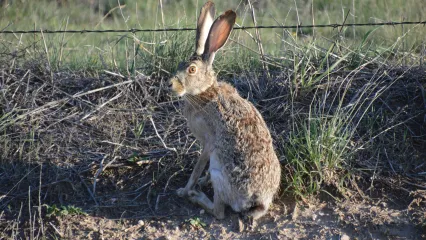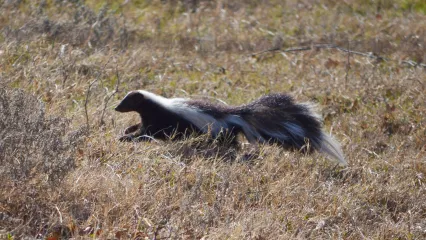
Description
The red fox (Vulpes vulpes) is likely one of the most striking and beautiful animals that can be seen in Oklahoma. Not to be confused with its cousin, the gray fox (Urocyon cinereoargenteus), the red fox is easily identified by its red coat and bushy and white-tipped tail. While red is the primary coat color, yellow-gold and even black is also seen.
Their prey choices are also highly varied. While small rodents and rabbits constitute most of their diet, these foxes also eat earthworms, fruit, fish, reptiles, birds and even garbage. Larger mammals such as raccoons and muskrats are also consumed. Red foxes can chase down prey at speeds around 30 mph and can maintain a gallop for long periods. They are considered to be great swimmers and can climb trees in pursuit of prey. Sometimes, prey items are cached for consumption at a later date. Red foxes have been known to cache unbroken eggs and even live ducks.
While considered a native to North America, the red fox's home range was originally only in the northern United States and Canada. In the 1700s, Europeans brought and released red foxes, which then colonized the rest of what would become the United States. They were also introduced to Australia in 1868 and have spread through much of that continent. With such a large range, red foxes are considered the most widely distributed carnivore in the world.
These foxes are among the most common spreaders of rabies and carry other diseases such as canine parvovirus and canine distemper.
Size
Red foxes are built along the lines of a small dog with an average body and tail length of 36-41 inches and a typical weight of 10-15 pounds. However, specimens as heavy as 30 pounds have been recorded.
Habitat
Its success can be attributed to its highly adaptable nature. Red foxes are able to survive in semi-arid habitats, tundra, farmland, forests, and even in urban settings.
Life Cycle
Red foxes in Oklahoma will breed from December to April, but most breeding occurs in January and February. While red foxes do bark, during the breeding season they can produce a high-pitched screech or scream that has been described as sounding like a woman screaming. After breeding, the female fox, or vixen, will prepare a den that will be an underground burrow. After a gestation period of 52 days, one to 12 offspring are born, although a typical litter size is three to six pups. The pups are born with dark gray fur, which changes to red when they are about 3 months old. Pups can walk at three weeks and are typically weaned soon after five weeks. Red foxes can live about eight years in the wild.


